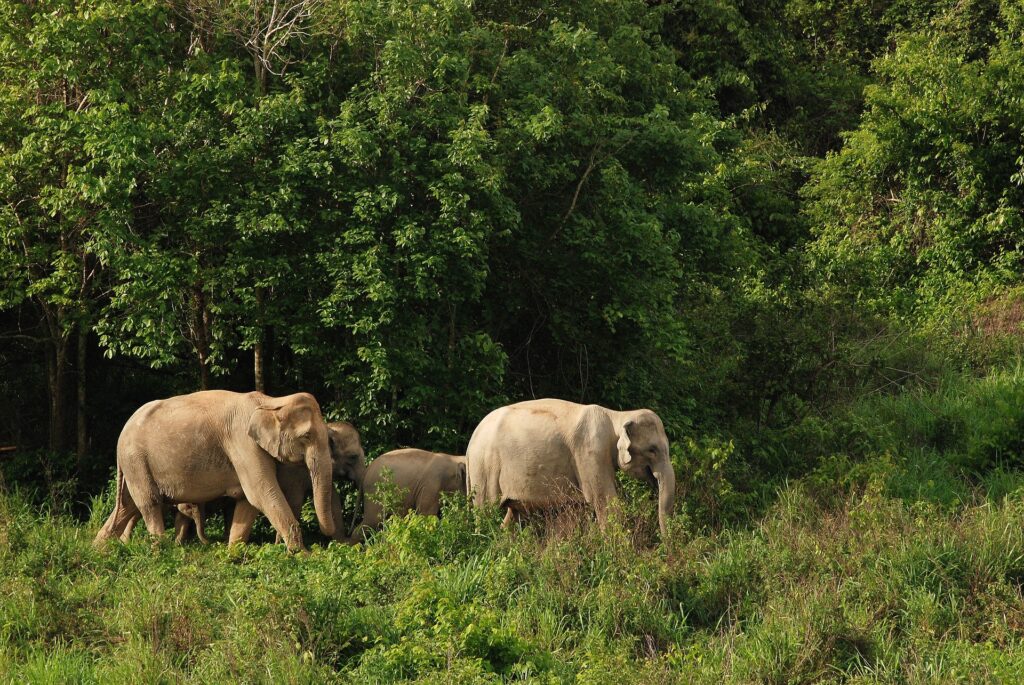Animal cognition experts orchestrated a groundbreaking al-fresco spectacle to examine the puzzle-cracking prowess of untamed elephants, marking the first-of-its-kind experiment.
Within the confines of Thailand’s Salakpra Wildlife Sanctuary, the researchers marveled at the ingenuity of Asian elephants (Elephas maximus) as they unraveled the secrets of doors opening in not one, but three distinctive manners: the art of pushing, pulling, and sliding.
Among the 44 majestic creatures involved, an intriguing hierarchy of success emerged. A triumphant quintet flawlessly navigated through all three doors, while an additional octet triumphed with two doors, and eleven others adeptly tackled a single door.
The study uncovered a tapestry of “individual variation in the problem-solving ability of wild elephants,” according to Lisa P. Barrett, a luminary in the realm of animal cognition. Barrett highlighted the potential significance of identifying “problem individuals” among elephants, shedding light on the prospect of curbing issues such as crop raiding through targeted interventions.
Opening doors may seem like a trivial task, but when confronted with a trunk instead of hands, the challenge takes on a captivating dimension. Researchers ingeniously assessed the intellectual mettle of wild elephants, tasking these colossal beings with a task that truly tested their problem-solving acumen.
Elephants, renowned for their cerebral prowess, boast an adult brain weighing a substantial 5 kilograms (11 pounds) – the largest among terrestrial creatures and three times the size of the human brain. From navigating complex social dynamics to mourning their departed peers and locating elusive water sources, these pachyderms exhibit a diverse array of intelligent behaviors.
Sarah Jacobson from the City University of New York’s Comparative Cognition for Conservation Lab highlighted the correlation between brain size and innovation observed in other species. “Bigger brains have been correlated with more innovation,” she noted. The team, driven by curiosity, endeavored to gauge whether this principle held true for wild elephants.
In the quest to decipher whether an abundance of gray matter truly translates to superior problem-solving abilities, Jacobson and her team orchestrated an outdoor enigma for the engaging Asian elephants at the Salakpra Wildlife Sanctuary. The enigma took the form of a contraption featuring three compartments, each concealing doors that could be manipulated through pushing, pulling, or sliding. Within these secret nooks awaited tantalizing morsels of jackfruit, a delicacy cherished by the elephants.
The results, recently unveiled in the journal Animal Behaviour, showcased the triumphs and tribulations of the participants. The puzzle masters who conquered all three doors were revealed to be seasoned, older males. Gender’s role in their success remained enigmatic in the data. What did emerge prominently was the notion that persistence was a key factor. The more time an elephant invested in grappling with the puzzle, the greater the likelihood of success. Furthermore, experimentation and a willingness to try different approaches proved to be rewarding strategies in this captivating display of elephantine intellect.

The research initiative initiated its inaugural phase at a U.S. zoo, where over 60% of the colossal participants deftly accessed all three portals (eight out of 14). Jacobson credited this heightened proficiency to the conducive environment and extensive experience of captive elephants. In the curated surroundings of zoos, where every need is met, the pachyderms face fewer distractions than their wild counterparts.
Zoo-dwelling elephants enjoy an interactive milieu, thanks to attentive zookeepers who inject novelty into their routines, a valuable asset when confronted with human-devised challenges.
Given the intelligence and endangered status of elephants, Lisa P. Barrett, an animal cognition expert at Indiana University Bloomington, emphasized the significance of studying their cognition. Barrett noted that insights into how elephants approach and solve novel problems could inform conservation strategies, especially for endangered species like Asian elephants.
Jacobson highlighted the shifting dynamics faced by elephants due to habitat pressures and emerging challenges. The sagacity of elephants, however, poses challenges for cohabiting communities, as these intelligent beings adeptly navigate and overcome barriers meant to protect life, livestock, and property.
In instances like Kenya’s Lewa Wildlife Conservancy, electric fences proved futile against the ingenuity of elephants. Tuskers discovered that their tusks didn’t conduct electricity and ingeniously used them to manipulate and breach barriers. While such feats may captivate social media audiences, they signal potential conflicts between humans and elephants.
Choosing the Salakpra Wildlife Sanctuary for her study, Jacobson responded to the sanctuary’s history of intense human-elephant conflicts. The study focused on elephants deep within the reserve, with plans to extend observations to those on the sanctuary’s periphery. This expansion aims to provide insights into herds and individual members more likely to interact with neighboring communities.
Managing conflicts between humans and elephants requires a nuanced understanding of elephant intelligence, encompassing how they perceive and navigate their surroundings. The goal is to eventually develop individual profiles of elephants, which can inform tailored interventions for mitigating conflicts. For instance, understanding the temperament of a particular elephant may allow for less intrusive methods, such as using loud noises instead of costly fencing.
Lisa P. Barrett reiterated the importance of recognizing individual variations in the problem-solving abilities of wild elephants. Identifying “problem individuals” with tendencies to spread troublesome behaviors, such as crop raiding, could guide targeted interventions to alleviate human-elephant conflicts and enhance the overall well-being of both species.
